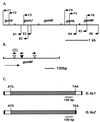Stationary-phase variation due to transposition of novel insertion elements in Xanthomonas oryzae pv. oryzae
- PMID: 10940020
- PMCID: PMC111356
- DOI: 10.1128/JB.182.17.4797-4802.2000
Stationary-phase variation due to transposition of novel insertion elements in Xanthomonas oryzae pv. oryzae
Abstract
Xanthomonas oryzae pv. oryzae causes bacterial leaf blight, a serious disease of rice. Spontaneous mutants which are deficient for virulence and extracellular polysaccharide (Eps) production accumulate in large numbers in stationary-phase cultures of this bacterium, a phenomenon which we have called stationary-phase variation. A clone (pSD1) carrying the Eps biosynthetic gene (gum) cluster of X. oryzae pv. oryzae restored Eps production and virulence to several spv (for stationary-phase variation) mutants. Data from localized recombination analysis, Southern hybridization, PCR amplification, and sequence analysis showed that the mutations are due to insertion of either one of two novel endogenous insertion sequence (IS) elements, namely, ISXo1 and ISXo2, into gumM, the last gene of the gum gene cluster. The results of Southern analysis indicate the presence of multiple copies of both IS elements in the genome of X. oryzae pv. oryzae. These results demonstrate the role of IS elements in stationary-phase variation in X. oryzae pv. oryzae.
Figures





References
-
- Altschul S F, Gish W, Miller W, Myers E W, Lipman D J. Basic local alignment search tool. J Mol Biol. 1990;215:403–410. - PubMed
-
- Capage, M. A., D. H. Doherty, M. Betlach, and R. W. Vanderslice. September 1996. Recombinant DNA mediated production of xanthan gum. U.S. patent 5,559,015.
-
- Coplin D L, Cook D. Molecular genetics of extracellular polysaccharide biosynthesis in vascular phytopathogenic bacteria. Mol Plant-Microbe Interact. 1990;3:271–279. - PubMed
-
- Dharmapuri S, Sonti R V. A transposon insertion in the gumG homologue of Xanthomonas oryzaepv. oryzae causes loss of extracellular polysaccharide production and virulence. FEMS Microbiol Lett. 1999;179:53–59. - PubMed
Publication types
MeSH terms
Substances
Associated data
- Actions
- Actions
- Actions
- Actions
LinkOut - more resources
Full Text Sources
Other Literature Sources

